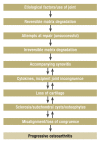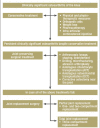The epidemiology, etiology, diagnosis, and treatment of osteoarthritis of the knee
- PMID: 20305774
- PMCID: PMC2841860
- DOI: 10.3238/arztebl.2010.0152
The epidemiology, etiology, diagnosis, and treatment of osteoarthritis of the knee
Erratum in
- Dtsch Arztebl Int. 2010 Apr;107(16):294
Abstract
Background: Osteoarthritis is the most common joint disease of adults worldwide. Its incidence rises with age. Both intrinsic and extrinsic risk factors promote its development. In men aged 60 to 64, the right knee is more commonly affected; in women, the right and left knees are affected with nearly equal frequency.
Methods: The PubMed, Medline, Embase and Cochrane Library databases were selectively searched for current studies (up to September 2009; case reports excluded) on the epidemiology, etiology, diagnosis, staging, and treatment of osteoarthritis of the knee. The search terms were "gonarthrosis," "prevention," "conservative treatment," "joint preservation," "physical activity," "arthroscopy," "osteotomy," "braces," "orthoses," and "osteoarthritis knee joint."
Results and conclusion: Osteoarthritis is not yet a curable disease, and its pathogenesis remains unclear. The best treatment for osteoarthritis of the knee is prevention. The goal of therapy is to alleviate clinical manifestations. The therapeutic spectrum ranges from physiotherapy and orthopedic aids to pharmacotherapy and surgery.
Figures






Comment in
-
Correspondence (letter to the editor): effects of acupuncture.Dtsch Arztebl Int. 2010 Aug;107(34-35):602; author reply 604. doi: 10.3238/arztebl.2010.0602b. Epub 2010 Aug 30. Dtsch Arztebl Int. 2010. PMID: 20838453 Free PMC article. No abstract available.
-
Correspondence (letter to the editor): almost Ineffective.Dtsch Arztebl Int. 2010 Aug;107(34-35):602. doi: 10.3238/arztebl.2010.0602a. Epub 2010 Aug 30. Dtsch Arztebl Int. 2010. PMID: 20838454 Free PMC article. No abstract available.
References
-
- Felson DT. Epidemiology of knee and hip osteoarthritis. Epidemiol Rev. 1988;10:1–28. - PubMed
-
- Felson DT, Couropmitree NN, Chaisson CE, et al. Evidence for a Mendelian gene in a segregation analysis of generalized radio-graphic osteoarthritis. The Framingham Study. Arthr Rheum. 1998;41:1064–1071. - PubMed
-
- Andrianakos AA, Kontelis LK, Karamitsos DG, et al. Prevalence of symptomatic knee, hand and hip osteoarthritis in Greece. The ESORDIG study. J Rheumatology. 2006;33:2507–2513. - PubMed
-
- D’Ambrosia RD. Epidemiology of osteoarthritis. Orthopedics. 2005;28(Suppl. 2):201–205. - PubMed
-
- Otte P. Gelenkerhaltung - Gefährdung - -Destruktion. Teil 1: Osteochondrale Strukturen. Nürnberg: Novartis; 2000. Der Arthrose-Prozeß.
Publication types
MeSH terms
Substances
LinkOut - more resources
Full Text Sources
Other Literature Sources
Medical

